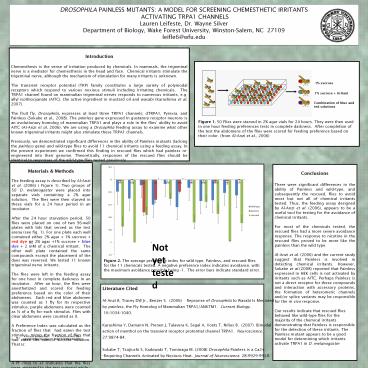DROSOPHILA PAINLESS MUTANTS: A MODEL FOR SCREENING CHEMESTHETIC IRRITANTS PowerPoint PPT Presentation
Title: DROSOPHILA PAINLESS MUTANTS: A MODEL FOR SCREENING CHEMESTHETIC IRRITANTS
1
DROSOPHILA PAINLESS MUTANTS A MODEL FOR
SCREENING CHEMESTHETIC IRRITANTS ACTIVATING
TRPA1 CHANNELS Lauren Leifeste, Dr. Wayne
Silver Department of Biology, Wake Forest
University, Winston-Salem, NC 27109 leifle6_at_wfu.e
du
Introduction Chemesthesis is the sense of
irritation produced by chemicals. In mammals, the
trigeminal nerve is a mediator for chemesthesis
in the head and face. Chemical irritants
stimulate the trigeminal nerve, although the
mechanism of stimulation for many irritants is
unknown. The transient receptor potential (TRP)
family constitutes a large variety of polymodal
receptors which respond to various noxious
stimuli including irritating chemicals. The
TRPA1 channel found on mammalian trigeminal
nerves responds to numerous irritants, e.g. allyl
isothiocyanate (AITC), the active ingredient in
mustard oil and wasabi (Karashima et al,
2007). The fruit fly, Drosophila, expresses at
least three TRPA1 channels dTRPA1, Pyrexia, and
Painless (Sokabe et al., 2008). The painless gene
expressed in gustatory receptor neurons is an
evolutionary homolog of mammalian TRPA1 and plays
a role in the flies ability to avoid AITC
(Al-Anzi et al, 2006). We are using a Drosophila
feeding assay to examine what other known
trigeminal irritants might also stimulate these
TRPA1 channels. Previously, we demonstrated
significant differences in the ability of
Painless mutants (lacking the painless gene) and
wild-type flies to avoid 11 chemical irritants
using a feeding assay. In the present experiment
we confirmed this finding in rescued flies which
had painless re-engineered into their genome.
Theoretically, responses of the rescued flies
should be identical to responses of the wild-type
flies tested previously
1 sucrose
1 sucrose irritant
Combination of blue and red solutions
Figure 1. 50 Flies were starved in 2 agar vials
for 24 hours. They were then used in one hour
feeding preferences tests in complete darkness.
After completion of the test the abdomens of the
flies were scored for feeding preference based on
their color. (from Al-Anzi et al., 2006)
Materials Methods The feeding assay is
described by Al-Anzi et al. (2006) ( Figure 1).
Two groups of 50 D. melanogaster were placed into
separate vials containing a 2 agar solution.
The flies were then starved in these vials for a
24 hour period in an incubator. After the 24
hour starvation period, 50 flies were placed on
one of two 96-well plates with lids that served
as the test arena (see fig. 1). For one plate
each well contained either 2 agar 1 sucrose
red dye or 2 agar 1 sucrose blue dye 2 mM
of a chemical irritant. The other well plate
contained the same compounds except the placement
of the dyes was reversed. We tested 11 known
trigeminal nerve irritants. The flies were left
in the feeding assay for one hour in complete
darkness in an incubator. After an hour, the
flies were anesthetized and scored for feeding
preference based on the color of their abdomens.
Each red and blue abdomen was counted as 1 fly
for its respective stimulus purple abdomens were
counted as ½ of a fly for each stimulus. Flies
with clear abdomens were counted as 0. A
Preference Index was calculated as the fraction
of flies that had eaten the test stimulus, minus
the fraction of flies that had eaten the control
sucrose solution. That is A PI
close to 1 indicates that the flies were
attracted to the test material while -1 indicates
an avoidance.
Conclusions There were significant differences
in the ability of Painless and wild-type, and
subsequently the rescued, flies to avoid most but
not all of chemical irritants tested. Thus, the
feeding assay designed by Al-Anzi et al. (2006),
appears to be a useful tool for testing for the
avoidance of chemical irritants. For most of
the chemicals tested, the rescued flies had a
more severe avoidance response. The response to
nicotine in the rescued flies proved to be more
like the painless than the wild type. Al-Anzi
et al. (2006) and the current study suggest that
Painless is involved in detecting chemical
irritants. However, Sokabe et al.(2008) reported
that Painless expressed in HEK cells is not
activated by irritants such as AITC. Perhaps
Painless is not a direct receptor for these
compounds and interaction with accessory
proteins, the formation of heteromeric channels
and/or splice variants may be responsible for the
in vivo response. Our results indicate that
rescued flies behaved like wild-type flies for
the majority of the chemical irritants
demonstrating that Painless is responsible for
the detection of these irritants. The Painless
mutant appears to be a good model for determining
which irritants activate TRPA1 in D.
melanogaster
Not yet tested
Figure 2. The average preference index for wild
type, Painless, and rescued flies for the 11
chemicals tested. A negative preference index
indicates avoidance, with the maximum avoidance
possible being -1. The error bars indicate
standard error.
Literature Cited Al-Anzi B, Tracey DW Jr.,
Benzer S. (2006) Repsonse of Drosophila to
Wasabi Is Mediated by painless, the Fly Homolog
of Mammalian TRPA1/ANKTM1. Current Biology.
161034-1040. Karashima Y, Damann N, Prenen J,
Talavera K, Segal A, Voets T, Nilius B. (2007)
Bimodal action of menthol on the transient
receptor protential channel TRPA1. Neuroscience.
279874-84. Sokabe T, Tsujiuchi S, Kadowaki T,
Tominaga M. (2008) Drosophila Painless is a
Ca2 -Requiring Channels Activated by Noxiuos
Heat. Journal of Neuroscience. 289929-9938.

